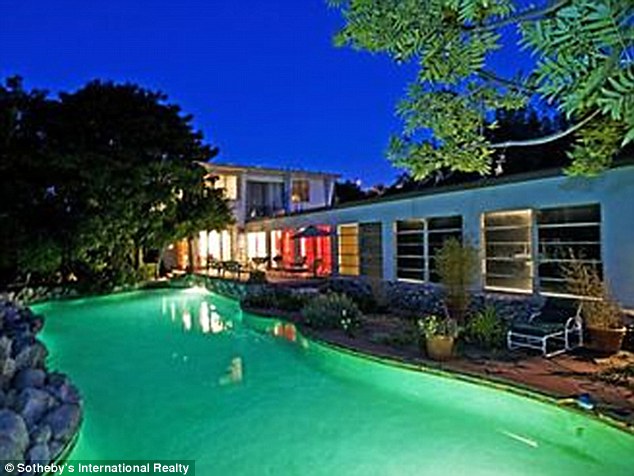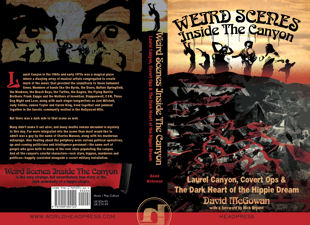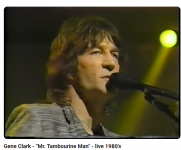Buick Electra
TB2K Girls with Guns
(Part 18 - Post 2 of 3)
Within the walls of that singularly odd Hollywood Hills home, which lies about three miles due east of the mouth of Laurel Canyon, Tamar talks of how she “often ‘uncomfortably’ posed nude … for ‘dirty-old-man’ Man Ray and had once wriggled free from a predatory John Huston.” Her own father, not so shockingly, “had committed incest with her. ‘When I was 11, my father taught me to perform oral sex on him.’” Her father also “plied her with erotic books, grooming her for what he touted as their transcendent union,” and freely shared her with his wealthy and influential friends.
“To the girl’s horror, she became pregnant” at the tender age of fourteen – with her father’s child. “To her greater horror, she says, ‘my father wanted me to have his baby.’” A friend, nevertheless, took her to get an abortion. Dr. George was so incensed that, according to Tamar, he “struck her on the head with his pistol,” prompting her step-mother (who also happened to be John Huston’s ex-wife) to assist her in going into hiding.
Dr. George Hodel was arrested and charged with, among other things, offering his young daughter to several friends at an orgy. The sensational 1949 incest trial featured a witness who took the stand to describe being hypnotized by Hodel at a party; she also claimed that she had witnessed him attempt to hypnotize other young women.
Allegations that the rich and powerful were dabbling in incest, hypnotism/mind control, pedophilic orgies, and Luciferian philosophies must surely have been shocking to Angelenos in the 1940s, as they would still be to most Americans today, but to these jaded eyes and ears, it just sounds like business as usual. Also sounding like business as usual is that Tamar was roundly vilified by both the press and the defense team (led by Jerry Giesler), and Dr. George Hodel was acquitted.
Far more shocking even than all of that is the then-unknown fact that, even while Hodel was standing trial on the sensational charges, he was, and still is today, a prime suspect in the Black Dahlia murder case! There have been, of course, numerous suspects identified in the case, including actor/director Orson Welles. But George Hodel does seem to be a much more likely suspect than most of those who have been identified. And his possible guilt, needless to say, does not exclude others from likely complicity as well. The mistake that virtually all investigators of this case have made is assuming that there is only one culprit.
The most likely scenario is that Hodel committed the crime in conjunction with various others in his pedophilic, Luciferian social circle. Man Ray, for example, is a compelling suspect, given that the posing of Ms. Short’s body appears to mimic The Minotaur, one of his better-known photographs. Man Ray, by the way, was something of the Robert Mapplethorpe of his era – the same Robert Mapplethorpe, it should be noted, whom investigative journalist Maury Terry has similarly linked to the Son of Sam case and various other ritualized murders (for more on George Hodel, Man Ray and the Black Dahlia murder, see Black Dahlia Avenger by Steve Hodel [George’s son and a former LAPD homicide detective] and Exquisite Corpse by Mark Nelson and Sarah Hudson Bayliss).
How it is that the fourteen-year-old daughter of a lowly probation officer fell into the orbit of the daughter of the wealthy and influential George Hodel (Hodel’s former home is currently valued at $4.2 million) has never been explained, but Tamar, described by Michelle as “the epitome of glamour,” quickly took the youngster under her wing, buying her clothes, enrolling her in modeling school, teaching her to drive, and providing her with a fake ID and a steady stream of prescription drugs – obtained, one would presume, from her father. [BE: Sounds like the pre-cursor to Jeffrey Epstein]
According to Michelle, “Tamar put on perfect airs around my dad and when it became necessary she would sleep with him.” Whatever works, I guess. That perhaps explains why, in early 1961, Gil didn’t have a problem with allowing his underage daughter to move to San Francisco with the daughter of a violent pedophile. Soon enough, Tamar found herself in a relationship with Journeyman Scott McKenzie, and bandmate John Phillips began coming by Tamar and Michelle’s room on a nightly basis.
It wasn’t long before Michelle, still just seventeen, was romantically involved with twenty-six-year-old Phillips, despite the fact that John was still married to Adams, with whom he by then had two children, Laura MacKenzie Phillips having been born on November 10, 1959 in Alexandria. Father Gil, who had himself recently taken a sixteen-year-old bride (one of a string of six wives), still wasn’t concerned. And it’s probably safe to assume that Phillip’s father, who had pursued his bride when she was just fifteen, wouldn’t have been too concerned either.
In October 1962, a year or so after meeting Michelle, John curiously found himself in Jacksonville, Florida (alongside Naval Air Station Jacksonville and Naval Station Mayport) for “two weeks of rest and rehearsal” during the Cuban Missile Crisis. For a guy who “never felt comfortable with political advocacy,” John seems to have had a keen interest in Cuban affairs. Two months later, on New Years Eve 1962, Holly Michelle Gilliam became John Phillip’s second wife. She also joined his reconfigured band, as did Canadian Denny Doherty, who had formerly been with the Mugwumps alongside Cass Elliot. This new lineup was dubbed the New Journeymen.
The newly-formed trio promptly embarked on a curious Caribbean adventure, [BE: Ahhh, 'The Islands!' ] arriving first at St. Johns, where John has claimed that they “snorkeled on acid” for several weeks. They next ferried over to St. Thomas, where they set up camp at a dive beachfront boardinghouse known as Duffy’s. Soon enough, Ellen Naomi Cohen, better known as Cass Elliot, showed up with John’s nephew, who was a childhood friend of hers. Cass had been born in Baltimore but had grown up in Alexandria, where, like Phillips, she had attended George Washington High School.
As the legend goes, Cass waited tables at the dive while the trio performed folk songs. What they were really doing there remains something of a mystery, though in Papa John, Phillips did drop a clue: “The town was crawling with drunken Marines and sailors on their way home from Vietnam.”
Moving on from the boardinghouse, the group next took over an unfinished home on Creeque Alley, where, according to John, they were known as “the island’s open house and everyone was welcome to our commune.” At some point though the governor supposedly ordered them off the island “because he thought his nephew was doing drugs with the crazies at Creeque Alley.” The band had formalized its new lineup of John Phillips, Michelle Phillips, Denny Doherty and Cass Elliot, and they had a whole album’s worth of material written. That first album would feature such enduring classics as California Dreamin’, Monday, Monday, and Go Where You Wanna Go. On none of the bands subsequent albums would they produce anywhere near the level of songwriting that they were allegedly able to achieve on that Caribbean adventure.
Though isolated on that Caribbean island, the songs the group brought back to LA with them just happened to be of the soon-to-emerge folk-rock variety. In Papa John, Phillips quotes Doherty as saying that everyone was “evolving toward the same sound at the same time without really communicating with each other about it.” It was, I suppose, just the way things were fated to be – or it could be that everyone was following the same script, written by unseen others.
Before helping to spearhead the folk-rock movement though, the quartet first had to get off the island, which Phillips presents as a high-risk venture: “We tried to get off the island quietly. We split in groups at the airport to look inconspicuous … We went at night so there wouldn’t be any credit checks done on me.”
Within a month of arriving in LA, the band had a producer/manager (Lou Adler, a Jewish kid who had grown up in a tough, Hispanic section of East LA) and a record deal, and John and Michelle were at home in a comfortable house on Lookout Mountain in Laurel Canyon. They would soon be able to afford to purchase Jeanette McDonald’s former Bel Air mansion at 783 Bel Air Road, which featured “hand-carved wooden gargoyles” and “a walk-in vault beneath the house,” which, as I already mentioned, is a very handy feature. Sitting on five acres, the lavish home, with five Rolls Royces in the driveway, was the site of virtually nonstop partying.
The new lineup, of course, needed a name, and John pushed hard for the occult-based Magic Cyrcle, which the band was briefly known as before ultimately settling on The Mamas and the Papas. There would be other indications as well that Phillips had a keen interest in the occult. He would later, for example, start his own label and call it Warlock Records. And his third wife, Genevieve Waite, was an avid follower of Aleister Crowley.
The Mamas and the Papas proved to be a rather short-lived band, recording and performing just from 1965 to 1968 (with a brief reunion in 1971 to satisfy contractual obligations to their record company). During that time, the band produced five albums and eleven top 40 singles. To date, the lineup has sold nearly 100,000,000 albums.
The first single, released in 1965, was Go Where You Wanna Go, which failed to chart. Their next release, California Dreamin’, shot up to #4. Their freshman album, If You Can Believe Your Eyes and Ears, released in early 1966, rose to the very top of the charts, their only album to do so. Their only #1 single, Monday, Monday, followed the release of the album. It was all downhill from there.
Within the walls of that singularly odd Hollywood Hills home, which lies about three miles due east of the mouth of Laurel Canyon, Tamar talks of how she “often ‘uncomfortably’ posed nude … for ‘dirty-old-man’ Man Ray and had once wriggled free from a predatory John Huston.” Her own father, not so shockingly, “had committed incest with her. ‘When I was 11, my father taught me to perform oral sex on him.’” Her father also “plied her with erotic books, grooming her for what he touted as their transcendent union,” and freely shared her with his wealthy and influential friends.
“To the girl’s horror, she became pregnant” at the tender age of fourteen – with her father’s child. “To her greater horror, she says, ‘my father wanted me to have his baby.’” A friend, nevertheless, took her to get an abortion. Dr. George was so incensed that, according to Tamar, he “struck her on the head with his pistol,” prompting her step-mother (who also happened to be John Huston’s ex-wife) to assist her in going into hiding.
Dr. George Hodel was arrested and charged with, among other things, offering his young daughter to several friends at an orgy. The sensational 1949 incest trial featured a witness who took the stand to describe being hypnotized by Hodel at a party; she also claimed that she had witnessed him attempt to hypnotize other young women.
Allegations that the rich and powerful were dabbling in incest, hypnotism/mind control, pedophilic orgies, and Luciferian philosophies must surely have been shocking to Angelenos in the 1940s, as they would still be to most Americans today, but to these jaded eyes and ears, it just sounds like business as usual. Also sounding like business as usual is that Tamar was roundly vilified by both the press and the defense team (led by Jerry Giesler), and Dr. George Hodel was acquitted.

Far more shocking even than all of that is the then-unknown fact that, even while Hodel was standing trial on the sensational charges, he was, and still is today, a prime suspect in the Black Dahlia murder case! There have been, of course, numerous suspects identified in the case, including actor/director Orson Welles. But George Hodel does seem to be a much more likely suspect than most of those who have been identified. And his possible guilt, needless to say, does not exclude others from likely complicity as well. The mistake that virtually all investigators of this case have made is assuming that there is only one culprit.
The most likely scenario is that Hodel committed the crime in conjunction with various others in his pedophilic, Luciferian social circle. Man Ray, for example, is a compelling suspect, given that the posing of Ms. Short’s body appears to mimic The Minotaur, one of his better-known photographs. Man Ray, by the way, was something of the Robert Mapplethorpe of his era – the same Robert Mapplethorpe, it should be noted, whom investigative journalist Maury Terry has similarly linked to the Son of Sam case and various other ritualized murders (for more on George Hodel, Man Ray and the Black Dahlia murder, see Black Dahlia Avenger by Steve Hodel [George’s son and a former LAPD homicide detective] and Exquisite Corpse by Mark Nelson and Sarah Hudson Bayliss).
How it is that the fourteen-year-old daughter of a lowly probation officer fell into the orbit of the daughter of the wealthy and influential George Hodel (Hodel’s former home is currently valued at $4.2 million) has never been explained, but Tamar, described by Michelle as “the epitome of glamour,” quickly took the youngster under her wing, buying her clothes, enrolling her in modeling school, teaching her to drive, and providing her with a fake ID and a steady stream of prescription drugs – obtained, one would presume, from her father. [BE: Sounds like the pre-cursor to Jeffrey Epstein]
According to Michelle, “Tamar put on perfect airs around my dad and when it became necessary she would sleep with him.” Whatever works, I guess. That perhaps explains why, in early 1961, Gil didn’t have a problem with allowing his underage daughter to move to San Francisco with the daughter of a violent pedophile. Soon enough, Tamar found herself in a relationship with Journeyman Scott McKenzie, and bandmate John Phillips began coming by Tamar and Michelle’s room on a nightly basis.
It wasn’t long before Michelle, still just seventeen, was romantically involved with twenty-six-year-old Phillips, despite the fact that John was still married to Adams, with whom he by then had two children, Laura MacKenzie Phillips having been born on November 10, 1959 in Alexandria. Father Gil, who had himself recently taken a sixteen-year-old bride (one of a string of six wives), still wasn’t concerned. And it’s probably safe to assume that Phillip’s father, who had pursued his bride when she was just fifteen, wouldn’t have been too concerned either.
In October 1962, a year or so after meeting Michelle, John curiously found himself in Jacksonville, Florida (alongside Naval Air Station Jacksonville and Naval Station Mayport) for “two weeks of rest and rehearsal” during the Cuban Missile Crisis. For a guy who “never felt comfortable with political advocacy,” John seems to have had a keen interest in Cuban affairs. Two months later, on New Years Eve 1962, Holly Michelle Gilliam became John Phillip’s second wife. She also joined his reconfigured band, as did Canadian Denny Doherty, who had formerly been with the Mugwumps alongside Cass Elliot. This new lineup was dubbed the New Journeymen.
The newly-formed trio promptly embarked on a curious Caribbean adventure, [BE: Ahhh, 'The Islands!' ] arriving first at St. Johns, where John has claimed that they “snorkeled on acid” for several weeks. They next ferried over to St. Thomas, where they set up camp at a dive beachfront boardinghouse known as Duffy’s. Soon enough, Ellen Naomi Cohen, better known as Cass Elliot, showed up with John’s nephew, who was a childhood friend of hers. Cass had been born in Baltimore but had grown up in Alexandria, where, like Phillips, she had attended George Washington High School.
As the legend goes, Cass waited tables at the dive while the trio performed folk songs. What they were really doing there remains something of a mystery, though in Papa John, Phillips did drop a clue: “The town was crawling with drunken Marines and sailors on their way home from Vietnam.”
Moving on from the boardinghouse, the group next took over an unfinished home on Creeque Alley, where, according to John, they were known as “the island’s open house and everyone was welcome to our commune.” At some point though the governor supposedly ordered them off the island “because he thought his nephew was doing drugs with the crazies at Creeque Alley.” The band had formalized its new lineup of John Phillips, Michelle Phillips, Denny Doherty and Cass Elliot, and they had a whole album’s worth of material written. That first album would feature such enduring classics as California Dreamin’, Monday, Monday, and Go Where You Wanna Go. On none of the bands subsequent albums would they produce anywhere near the level of songwriting that they were allegedly able to achieve on that Caribbean adventure.
Though isolated on that Caribbean island, the songs the group brought back to LA with them just happened to be of the soon-to-emerge folk-rock variety. In Papa John, Phillips quotes Doherty as saying that everyone was “evolving toward the same sound at the same time without really communicating with each other about it.” It was, I suppose, just the way things were fated to be – or it could be that everyone was following the same script, written by unseen others.
Before helping to spearhead the folk-rock movement though, the quartet first had to get off the island, which Phillips presents as a high-risk venture: “We tried to get off the island quietly. We split in groups at the airport to look inconspicuous … We went at night so there wouldn’t be any credit checks done on me.”
Within a month of arriving in LA, the band had a producer/manager (Lou Adler, a Jewish kid who had grown up in a tough, Hispanic section of East LA) and a record deal, and John and Michelle were at home in a comfortable house on Lookout Mountain in Laurel Canyon. They would soon be able to afford to purchase Jeanette McDonald’s former Bel Air mansion at 783 Bel Air Road, which featured “hand-carved wooden gargoyles” and “a walk-in vault beneath the house,” which, as I already mentioned, is a very handy feature. Sitting on five acres, the lavish home, with five Rolls Royces in the driveway, was the site of virtually nonstop partying.
The new lineup, of course, needed a name, and John pushed hard for the occult-based Magic Cyrcle, which the band was briefly known as before ultimately settling on The Mamas and the Papas. There would be other indications as well that Phillips had a keen interest in the occult. He would later, for example, start his own label and call it Warlock Records. And his third wife, Genevieve Waite, was an avid follower of Aleister Crowley.
The Mamas and the Papas proved to be a rather short-lived band, recording and performing just from 1965 to 1968 (with a brief reunion in 1971 to satisfy contractual obligations to their record company). During that time, the band produced five albums and eleven top 40 singles. To date, the lineup has sold nearly 100,000,000 albums.
The first single, released in 1965, was Go Where You Wanna Go, which failed to chart. Their next release, California Dreamin’, shot up to #4. Their freshman album, If You Can Believe Your Eyes and Ears, released in early 1966, rose to the very top of the charts, their only album to do so. Their only #1 single, Monday, Monday, followed the release of the album. It was all downhill from there.
Last edited:




 I can now veer off on wild tangents having little to do with the main topic of discussion – like filling you in, for example, on nonexistent twelve-step programs – and not feel the slightest compulsion to point out the temporary loss of focus.
I can now veer off on wild tangents having little to do with the main topic of discussion – like filling you in, for example, on nonexistent twelve-step programs – and not feel the slightest compulsion to point out the temporary loss of focus. It never hurts to have friends in high places.
It never hurts to have friends in high places.
 … A highly incredible story which persists is that a boy who was in his family some weeks mysteriously disappeared. He claims that the boy is now in his home in England, but still official letters of inquiry and demand are received from that country. This is no mere rumor, for I was shown some of the original letters … The matter has been going on for more than a year. It is very mysterious.”
… A highly incredible story which persists is that a boy who was in his family some weeks mysteriously disappeared. He claims that the boy is now in his home in England, but still official letters of inquiry and demand are received from that country. This is no mere rumor, for I was shown some of the original letters … The matter has been going on for more than a year. It is very mysterious.”


 "What a waste" said a bunch of teen girls looking to flirt with cute boys.
"What a waste" said a bunch of teen girls looking to flirt with cute boys. 